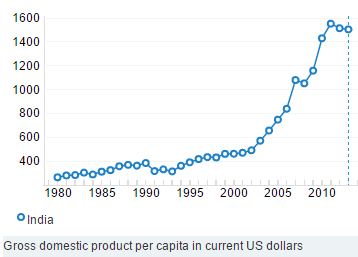After five years of decline, India jumps 16 ranks to 55th place in the Global Competitiveness Index of World Economic Forum(WEF)! Excellent indeed, now this is how India has fared:

This definitely bodes well for Indian industries and is an indicator of good things to come. There are definite reasons for this exponential growth and in this blog we explore some of them. We will stick to the IT and ITes sector and dig in to the factors influencing price competitiveness in particular.

Cost arbitrage and Value for money
A paper by Science Direct investigates the factors instrumental in imparting a competitive edge to the Indian IT-ITeS sector using a model called Porter’s diamond model. Here are a few gleanings:
Low-cost skilled labour is one of the vital factors contributing to the competitiveness of Indian IT. Drawing from a NASSCOM, 2013 study, the paper says:“Indian software professionals have tended to enjoy (absolute) wage advantages vis-à-vis their counterparts in the US and Europe. Estimated wage costs in India in 1997 were about 1/3 to 1/5 of the US levels for comparable work. The cost arbitrage remains unchanged even today notwithstanding the wage inflation due to decline in billing rates by around 5% in the last 4–5 years.” The fact that most of the technically trained manpower in India have proficiency in English also contributes to the competitive edge.
Global Head, Business Development at Mahindra Satyam, Mr. Manoj Chugh says “cost arbitrage is not compelling enough. Customers are looking for flexible offerings and managed services”The Indian IT and ITes sector definitely delivers on this according to the NASSCOM study, “the first US$ 100 billion attributable to wage arbitrage and the next US$ 100 billion achieved through a combination of high-value services and increasingly non-linear play manifested in a shift from enterprise services to enterprise solutions.” Continuous upgradation, agile delivery models, domain expertise and inclusion of delivery network in tier-2 and tier-3 cities have been factors that have increased the price advantage of labour here.
Price advantage has also been made possible owing to the low infrastructural costs for setting up a software unit. Entry barriers are therefore very low. Decline in hardware prices, increased software production, and low tax and tariff obligations imposed by the government have increased the viability of entrepreneurship in IT; Infosys, Wipro, Mahindra Satyam, Polaris and other top notch software firms have emerged through the years and this has led to correspondingly higher cost advantages.
Along with the competitiveness of price, innovations in technology has played a major role in the increasing competitiveness of Indian IT. IT and ITes is a knowledge-intensive industry and Indian IT is way ahead in this regard. One indicator of this is that the number of patents filed with the Indian IP office increased from 71 in 2005 to 2052 in 2008 according to another NASSCOM study. Proof enough that India is surging ahead in its quest for excellence in innovation; it is constantly stepping up in creating value-based pricing models, building domain expertise, and designing new technologies.

Innovative technologies
These are compelling reasons to believe that India has and will continue to gain a major competitive advantage in the global field. We are seeing this in action at Solutiontogo as we grow from limb to limb and show excellence in innovation with the benefits of cost advantage.






